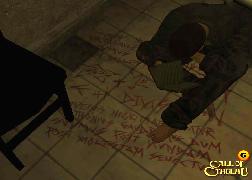
I felt like this guy while playing this game.

I felt like this guy while playing this game.

I’m sure she’s just planning to trim those bangs back.
The story, such as it is, involves a series of children vanishing from the streets in broad daylight. Rumor has it that they are victims of Kuchisake Onna, who has been released from imprisonment by a recent earthquake. Turns out the rumors are right: Kuchisake Onna is on the loose and has a bone to pick with just about everybody under the age of 11 (and any adults who happen to get in her way). The protagonist, a teacher at a local school who’s students are among the victims, must track Kuchisake Onna down and stop her from taking any more children. She’s aided by another teacher, who helpfully can hear a strange voice whenever Kuchisake Onna is about to strike. Together they must solve the mystery–blah blah, you know the rest.
As a movie, Kuchisake Onna is unfortunately pretty bad. It’s not cringe-worthy bad, but there’s very little to redeem it; the acting is pretty terrible, the script is atrocious, and the plot is both full of holes and entirely predictable. But it’s not a total train wreck: some of the photography is pretty good (though there are a few really noticeably bad cuts) and I liked the way the director used color filters to code different locations in the movie. The pacing is pretty weird: the movie just starts, with no introduction, and within the first few minutes we’ve already seen Kuchisake Onna take her first victim; there’s no build-up and consequently very little arc to the overall story. The ending, unfortunately, is pretty lame, as is the application of some not-so-tricky wordplay late in the film to connect the story with the legend upon which
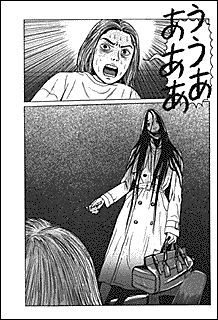
Minetaro Mochizuki’s Zashiki Onna
One thing I did like about the film is the way the antagonist, Kuchisake Onna herself, is portrayed. She shows up whenever she pleases, even in the middle of the day on a sunny street. There’s no need to wait for darkness or to explore the haunted mansion with flashlights at night (though that happens too–sigh), Kuchisake Onna is bad-ass enough to appear right in the middle of the day to grab children.
I also like the way the Kuchisake Onna looks: she is tall, has long hair, a surgical mask, and carries around some incredibly large shears. Actually, now that I think about it, I think her design was taken pretty much directly from the antagonist of Minetaro Mochizuki’s excellent horror comic Zashiki Onna. I’ve thought many times about translating Zashiki Onna (“Tatami Room Woman”) into English, as it’s such an awesome and well-written horror comic. At any rate, the design of Kuchisake Onna matches Mochizuki’s antagonist almost perfectly. That’s cool though–the design works, and it’s one of the best things about the movie.
The other, somewhat interesting (for aficionados, anyway) thing about the film is that it follows the modern Japanese horror film tradition of being about broken families. In this film, the subject is child abuse. As David Kalat points out in his fascinating book, non-nuclear family relationships are one of the core themes of modern (post-Ring) Japanese horror films. The thing is, nothing else about Kuchisake Onna really aligns to “J-Horror” (a term I abhor) conventions; it’s much more like a formulaic Hollywood slasher flick, with a heavy emphasis on body count and gore and no attempt at the subtlety favored by the recent classics of the genre. I wonder if the broken home theme was chosen because it fit the story (which it actually does) or simply to be like other modern Japanese horror films.
In any case, Kuchisake Onna is a pretty mediocre horror film that I think you are probably better off avoiding.
I know I’ve been fairly negative lately about the games I am playing. I really don’t want to just hate everything that comes my way and hold it up to some impossible golden standard, but damn, there’s been so much disappointment in my gaming life lately.
Take Call of Cthulhu: Dark Corners of the Earth, for instance. I really, really want to like this game. There are a ton of neat game play ideas in it, and the narrative is so well told. But part way through the game stopped being about horror and started being about shooting, and as a shooter it’s pretty miserable (even with my discovery of the Aim button–holy crap it was hard before that). The damage model is too unforgiving, the reload time is way too long, and your short-term goals are really unclear. I’ve had to use a faq twice now for this game (which I loathe to do), and both times the places that I got stuck at were really trivial tasks. I find myself playing the same section over and over again, not because it is hard to figure out what to do, but because it’s so easy to fail. These are sections that the game designers probably intended the player to spend less than five minutes on, and here I am wandering around for hours because an item that I needed to collect refused to be collected when I tried or because the subtitles don’t show up reliably. It doesn’t help that the health and damage systems, which I discussed in the previous post, are harsh even for a stealth game, and then the designers drop you into situations where gunplay is the only option. In these cases (like the raid on the boat) you basically can’t take any hits because you don’t have time to heal and even the most trivial hit will kill you eventually thanks to blood loss. Argh!
It is rare for me to feel so mixed about a game. Usually it’s a failure at every level, mediocre across the board, or consistently inspired. But with Call of Cthulhu, I’m finding a huge amount of variability in the moment-to-moment quality. The insanity effects, the audio design, the story, and the story telling are all excellent. The graphics are good and I like the character design, the dialog is well-written and well-acted, and the way the narrative branches is really interesting. But on the other hand, the gun play is a disaster (and a central game mechanic), the stealth aspects are unrewarding, and the game is really poor at communicating goals to the player. Some of the puzzles are needlessly obtuse (don’t tell me to go find an item that doesn’t actually exist, please) and the game has actually crashed on me twice now (though I am running under emulation on a 360, so I should probably give the developer the benefit of the doubt).
Call of Cthulhu should, by rights, be a great game. It’s got everything it needs to be absolutely awesome. And yet I feel like I have to punch myself in the face while playing it in order to get to the next awesome thing.
 One thing about having a kid is that you don’t sleep very much. But for me, that means that I’ve had some time to play some video games in between cuddling my daughter, feeding her, and generally trying to let her Mom get some sleep in the wee hours of the morning. For some reason I’ve been on a FPS tangent recently (actually, I know the reason: I bought a 360)–I’ve played through Halo, Half-Life 2 Episode 2, Portal (all kinds of awesome, by the way), and I’ve put a little bit of time into a couple of horror games: Call of Cthulhu: Dark Corners of the Earth and Condemned.
One thing about having a kid is that you don’t sleep very much. But for me, that means that I’ve had some time to play some video games in between cuddling my daughter, feeding her, and generally trying to let her Mom get some sleep in the wee hours of the morning. For some reason I’ve been on a FPS tangent recently (actually, I know the reason: I bought a 360)–I’ve played through Halo, Half-Life 2 Episode 2, Portal (all kinds of awesome, by the way), and I’ve put a little bit of time into a couple of horror games: Call of Cthulhu: Dark Corners of the Earth and Condemned.
Call of Cthulhu is a game that I really want to like because the narrative is so well told. We’ve got a by-the-books Lovecraftian tale here, and it’s executed within the game systems quite well. Flashbacks, insanity effects, and generally hot level design make the game play (which involves a lot of exploration, puzzle solving, and sneaking) pretty fun. That is, unfortunately, until they introduce the firearms. Once the guns show up, the game mechanics seem to fall apart. The story is still very well told, but the game play takes an immediate and dramatic nosedive. There are a couple of issues that together cause Call of Cthulhu to be way less fun than it should be. First of all, the shooting mechanics are terrible. There’s no aiming reticle, and the angle of the protagonists arm on the screen makes it really difficult to judge exactly where the gun is pointing. Furthermore, weapons that should have a significant target area (like the shotgun) sometimes miss at point blank range. The switching of weapons and reloading is also incredibly arduous–on the 360 pad, switching weapons while moving isn’t really possible because the D-Pad is used to select weapons, requiring you to take your thumb off the analog stick. Maybe it was easier under the original Xbox controller. None of this is helped by the fact that the enemies seem to be able to withstand much, much more damage than your character.
But even worse than the aiming mechanics is the damage system used in the Call of Cthulhu. The idea is that you can get hurt in different ways and need to bandage yourself up rather than just magically healing. Applying bandages and splints takes times, and leaves you vulnerable in the world. If you don’t bandage wounds, you can become further hurt by loss of blood. The problem with this system is that different types of wounds require different types of health items, and I perpetually seem to be out of the one that I need. And since you can just die by walking around with an unbandaged wound, it’s important to patch all of your wounds up all the time. Even then, an enemy with a shotgun can kill you in one hit, or his friend with the pistol can shoot you in the foot and laugh as you limp five feet away before dying of blood loss. I understand that the developers wanted to use resource management as a way to make healing more realistic and to make the player more vulnerable, but this implementation just makes playing the game unfun. It strikes me as similar to Illbleed–too many resources that interact in ways that are not totally clear.
I’m still trying to like Cthulhu, because like I said, everything else about the game is pretty phenomenal. It’s just that first person mechanics are really well defined at this point, and the shooting mechanics in Dark Corners of the Earth feel like a regression to 1996. I shall complete this game for the story alone, but I’m disappointed that the weak shooting mechanics replaced the much more interesting sneaking and puzzle solving aspects that dominated the first part of the game.
Condemed, on the other hand, appears to be freaking fantastic! I need to qualify that statement: I’ve only played the first hour or so of Condemned. But goddamn, what an awesome introduction. I’m really impressed with the art style, especially the use of lighting in the levels; the developers were able to get away with bright spaces without detracting from the feelings of claustrophobia and oppression that the dank environments are intended to invoke. The pressure upon the player is immediate and constant from the first moment of the game. I really hope it stays this good throughout its entire length.
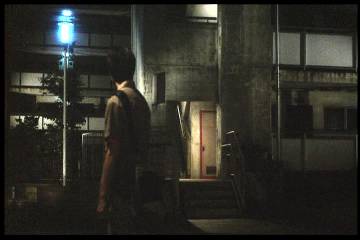
I have no clue what is going on in Pulse, but it’s awesome.
I have a couple of recommendations for this year’s Halloween. First, you could mull over the announcement that Capcom is making a Resident Evil CG movie. If that’s not enough for you, you could go rent yourself some quality horror films–none of this sanitized-for-television garbage, but the real, genuine article. I’ve recommend Pulse (the origin of this neat shot on the left), Session 9, The Descent, and Don’t Look Now in the past, and I would like to reiterate my approval of these films. Or, you could check out this fascinating (if somewhat informal) book about Japanese horror films. I’m about half way through it myself and will be posting a full review when I’m done, but so far it’s been pretty good. Finally, you could play some Call of Cthulhu: Dark Corners of the Earth, which I found mostly satisfactory until the shooting bits started, but I can still recommend it to fans of the genre (which, if you are reading this site, you clearly are).
Anyway, I have to go buy some candy and get myself a mask or something. I’m totally unprepared for all the kids that are going to be knocking at my door in a few short hours. Trick or treat!
Playstation Museum has a nice summary of Resident Evil 1.5, the unreleased precursor to Resident Evil 2. The YouTube video is already offline, but the overview and screenshots are very nice.
On a more personal note, I became a father this past Sunday! I don’t really use this space to talk about myself very much, but the birth of my daughter is probably the most important thing that has ever happened to me. I’m confident that she’ll grow up with a strong interest in zombies and killer nurses.
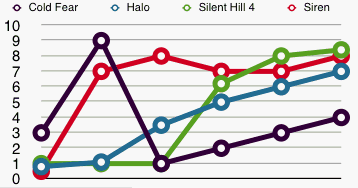
Graph 1: Difficulty over Time
So I thought about it for a bit and decided to visualize my complaint with Cold Fear in the form of the all-powerful line graph. I have two graphs to show, one tracking the difficulty of several games over time and the other showing the relative frustration I felt with those same games over the same amount of time. The levels here are completely subjective: I don’t expect other people to have felt exactly the same way as I did about these games, so before you get bent out of shape about how Siren is totally easy or Halo is amazingly hard and frustrating, realize that these are my impressions alone. Chill, ok?
You are probably like, “wait, did he say Halo?” Yeah, it seems a little out of place in this graph, I have to admit. But I am including it here for a good reason: it’s an extremely popular, extremely highly-rated game (also I just finished it the other day, so it’s fresh in my mind). If you get 97% on Metacritic.com and sell over 6 million copies, you have to be doing something very, very right. So I’m using Halo as a baseline in this graph to show how other games relate in terms of difficulty progression and frustration over time.
This first graph shows the level of difficulty I perceived for several games. You can see that Cold Fear started out fairly easy but then spiked really high early on. It was during this spike that I vented my frustration about the game on this blog. After that, the difficulty drops off very quickly and stays pretty shallow after that point (note that I’m not quite done with the game). Siren also started easy and then spiked dramatically. When this happened I ranted about it here. Unlike Cold Fear, Siren doesn’t get a whole lot easier over the course of the game–it stays pretty damn difficult until the very end. Silent Hill 4, on the other hand, was a walk in the park for the first half of the game and then suddenly became quite difficult in the second half. Finally, you can see that Halo’s difficulty curve is pretty uniform: it gets harder at a predictable rate but never spikes. It also never becomes super-difficult; even at its hardest, it is easier than Siren and Silent Hill 4. Halo has a very well-defined difficulty curve, while these other examples are less regular.
The second graph shows how frustrated I was by these games at different points in my play-through. You can see that Cold Fear got super frustrating at the same point that it was super difficult, prompting my rant. Siren was also super frustrating when the difficulty spiked, which is probably why I ranted about it as well. Silent Hill 4 was not very frustrating early on, but after a while the game became difficult and frustrating and stayed that way through the end. Halo has no spikes, and though the frustration level does rise with its difficulty, it manages to stay pretty frustration-free throughout the entire experience. It seems clear that spikes in difficulty are sources of frustration for me, but what I think is interesting about this graph is what happens to Siren after the spike: even though the game remained difficult, I was less frustrated by it the more I played it.
So what’s going on here? Cold Fear gets super hard and super frustrating and then becomes super easy and less frustrating. Siren gets super hard and super frustrating but then becomes more fun without losing any of its difficulty. If my theory is that hard games are frustrating, or even that dramatic spikes in difficulty are cause for frustration, it should follow that Siren would remain frustrating
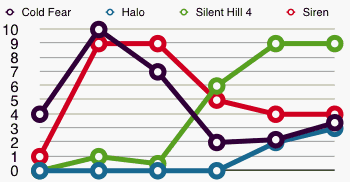
Graph 2: Frustration over Time
Here is my theory: frustration isn’t as much a function of difficulty as it is a function of communication with the player. In fact, unplanned spikes in difficulty are probably caused by poor player communication, which is also the source for frustration; the first graph is not the cause of the second, they are both side-effects of the same problem. As Halo demonstrates, when difficulty increases gradually, the player himself improves and no frustration is evident. Most designers probably intend for their games to become incrementally harder over time, so spikes in difficulty and frustration represent unplanned-for failures to communicate the rules of the game.
Let me elaborate by looking at why Cold Fear suddenly became so hard and frustrating for me:
Almost all of these problems are communication issues: the game didn’t tell me where to go, didn’t tell me when an auto-save was coming up (or how prepared for a fight I should be after the save), didn’t tell me that I was quickly using up resources on the ship, and didn’t make it easy to find my way around. None of them have much to do with the normal moment-to-moment game play; they are “meta design” problems. Also, I think that these problems occurred early in the game because it takes players a while to get a hang of all the rules. As game play progresses and the player gets the hang of the rule set, these sorts of communication errors are probably less frequent.
The problems plaguing Siren were similar. As I posted about later in my Siren experience (and expanded upon in my eventual review of the game), the spike in difficulty and frustration in Siren is caused by insufficient communication with the player about the mechanics of the game. The central mechanic, sneaking, isn’t even clear until the player gets to the point where they cannot progress without sneaking extremely carefully. What happened to me in Siren is that I didn’t understand how to play and got frustrated with it, but my frustration level dropped through the floor and I started having fun again when I eventually figured out how the developers wanted me to play. The game was still damn difficult, but once I understood the rules the difficulty seemed legitimate rather than arbitrary.
In fact, when I think about it, Silent Hill 4 is a similar story. The difficulty level spiked half way through the game because I didn’t understand how to take care of the apartment. In the first half of the game the apartment is a source of infinite health (you can return there to heal at any time), but if you fail to light candles this benefit is lost in the second half of the game. I missed the connection between the candles and the quality of the room, which meant I suddenly lost a way to regain health and the game’s previously trivial game play suddenly became extremely difficult (this mistake also meant I wasn’t able to get the best ending–damn it).
So my conclusion is that games that suddenly become frustratingly difficult are probably failing to teach the player what is expected of them and how the game is to be played. If this happens early enough in the game we can just call it a “steep learning curve” (it’s obvious within the first hour of Resident Evil that you must aggressively conserve ammo), but if it happens after the player has made significant progress, it makes the game feel like it is punishing the player arbitrarily–it’s suddenly a matter of luck rather than one of skill. Games like Halo are probably successful on such a huge scale because they teach the player the rules early on and then gradually increase the level of challenge without ever changing the rule set.
Speaking of Dementium: The Ward, here’s some game play footage. Doesn’t look half-bad!
I posted a little bit about Dementium: The Ward before, and since then the Horror FPS for DS has been mostly off my radar. The game is on schedule for release at the end of October (hooray for Halloween), and I am very interested to see if horror in a portable format will work.
But in the mean time, Dementium’s publisher Gamecock has been publishing their communications with the ESRB in an IGN “director’s diary.” I’m sure everybody knows that game developers get their games rated by the ESRB voluntarily (though no console maker will allow an un-rated game to be published for their system), but were you aware that ESRB certification also requires approval for video game ads and trailers!? The commentary over at IGN (beware, IGN) is sort of fascinating: the publisher made a pretty gross trailer for their game and the ESRB has forced them to censor it. Of course, thanks to the magic of the internet, we can watch the uncensored trailer over at Eurogamer.
The interesting thing to me is that the trailer is actually pretty terrible; it’s really not worth the effort it must have taken them to get everything censored. As with the Rule of Rose controversy, censorship is having the opposite of its intended effect: it has increased attention on work in question.
ESRB, your existence is useful because game developers need a third-party organization to rate their games. Games are a medium that span all age groups, and having a rating is a very easy way to raise awareness about the kinds of games that exist and curb offense from sensitive non-gamers without necessitating litigation. However, your usefulness ends there: you are not our mothers and we don’t need you to tell us what we can or cannot watch. If you want to issue ratings for trailers or whatever, be our guest. But don’t tell developers what they can and can not publish–that’s stepping across the boundary from classification to censorship. And come on, this is the internet–an infinite supply of offensive media far worse than any game commercial is waiting right behind that little Google search box. Any attempt to protect the user is moot; one mis-click and they can have goatse all over their screen. Give us the benefit of the doubt: if we have the internet, we can deal with video game trailers without your approval.
Ever since all this fuss about “next generation” started a couple of years ago, I’ve been pretty vocal about my ambivalence towards the whole ordeal. I don’t think that innovation in graphics is nearly as compelling as innovation in game design, and the games that are available for the next gen systems don’t seem like they are pushing the innovation envelope any more than the last generation (Wii excluded). In fact, the added pressure of making everything look all nice and next-genny seems like a very bad thing to me, as it increases the cost of game development and thereby decreases the chances that developers will attempt risky new designs. I also think that the price point for the Xbox360 and PS3 are pretty outrageous, especially since so many of the games seem like the same-old same-old with shininess and bloom effects applied.
So it’s hard not to sound a little hypocritical when I tell people that I bought an Xbox360 last weekend. I know what you are thinking, but the purchase had nothing to do with Halo 3. I’ve not played any of the Halo games yet, and when I start I’ll be playing them in order. No, I didn’t buy a 360 to play any particular game (though if I had to chose one, I’d label Stuntman 2 as the most likely candidate). I didn’t buy it for the updated graphics either, though wanting something to drive the HD TV I bought earlier this summer was probably a factor.
I still think that the 360 and PS3 are too expensive. And I still have yet to see a game that really takes advantage of that power to achieve something that would have been impossible in the previous generation (though Bioshock might be that game). I stand by my statement that rising costs in game development caused by the need to make better looking and more complex games will, at least in the short term, drive innovation down overall.
The part that I missed, the feature that ultimately sold me on the machine when I saw it in action at a friend’s house, is Xbox Live. I thought Live was simply a service for playing first person shooter games against prepubescent kids with anger management issues and a touch of Tourette syndrome, and while that assessment isn’t inaccurate, it doesn’t describe the breadth of features that the service provides. The ability to download game demos and get games off of Xbox Live Arcade in particular are killer features for me. I like to sample a wide range of games, and I’ve bought a lot of games that I’m not all that interested in just so that I can see how they work. Being able to download demos of commercial games before purchasing them is pretty great, and the Xbox Live Arcade seems to be full of cheap, innovative, fun games. Finally, being able to stream video from my Mac to the TV via the Xbox is all kinds of awesome.
And there are enough Xbox360 games out now that I should have plenty to throw at the console. The Darkness, Dead Rising, Stuntman 2, and Bioshock are all on my list of things to buy. Not to mention the few original Xbox games I missed out on last gen (basically Ninja Gaiden, Call of Cthulhu, and Halo).
So I’m pretty happy with the purchase, despite my rather anti-next gen stance. Next gen may represent a challenge for game developers, but the 360 itself seems pretty slick.